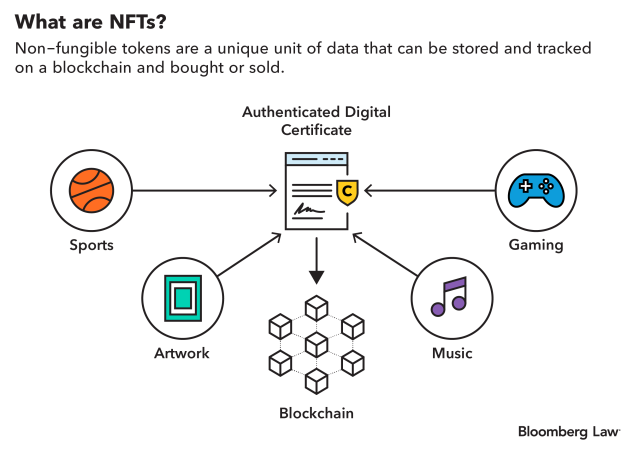This article was published as a part of the Data Science Blogathon.
Introduction
.png)
The trend of NFTs is quickly taking over the digital art and collectible world. Digital artists’ lives are changing drastically because they are selling a lot of work to a new crypto-audience. And, when famous people find a new way to connect with their loyal fans, they jump on the bandwagon too. But digital art is not the only place where we use NFTs. In reality, they can be used to show ownership of any unique object, just like a deed for a piece of property in either the digital or physical world.
The problem has gotten worse since NFTs became popular. Picture of apes are making millions of dollars, and such NFT projects are always in the news. Recent events may have made you think about a very important question: what is an NFT?
Then, let’s start with the most important things.
What does NFT mean?

Source: https://news.bloomberglaw.com/ip-law/the-trendy-hot-nft-market-has-a-new-entrant-patents
Because it is unique, the word NFT makes it clear that it can’t be changed or replaced in any way. Since they are both fungible, fiat currency and digital cryptocurrencies can be traded or swapped for each other. Because fungible tokens are interchangeable, they can be used as a way to do business.
At the beginning of March 2021, a set of non-fungible tokens (NFTs) created by the digital artist Beeple sold for more than $69 million. The transaction established a new standard and broke the previous mark for the most expensive piece of digital art ever to be purchased. Beeple’s first 5,000 days of work were collaged together to create the piece of art.
How does NFT work?
The blockchain technology that runs cryptocurrencies like Bitcoin and Ethereum makes it possible for NFTs to work. A blockchain is a group of computers that work together to keep a digital record of data. It is a completely decentralized system for keeping track of information that is almost impossible to hack or change on purpose.

-
Making a new building block
- Verification of information
- Adding information to the distributed ledger (blockchain)
Depending on the NFT, the purchase may include copyright and license rights. When you buy a print from a limited edition, you don’t get the picture all to yourself. As the technology and ideas behind NFTs improve, they may be used more and more outside of the arts.
What is the use of NFTs?
1. Digital Content
In the modern world, NFT s are used through Digital content. NFTs are the driving force behind a “creator economy,” which lets content creators give their work’s ownership to the platforms they use to distribute it in exchange for money. This means that the people who make the content make more money.
2. Gaming Items
People who make video games have shown a lot of interest in NFTs. When players take part in NFTs, they stand to gain a lot. Most of the time, the most you can do in an online game is buy accessories for your character or “avatar.” You can get the money back that you spent on NFTs by selling them when you’re done with them.
3. Domain Names
NFTs make the name of your domain shorter and easier to remember. This works the same way as a website’s domain name, making the IP address more valuable and easy to remember, often based on how long and relevant it is.
4. Physical Items
Tokenization that isn’t digital isn’t as advanced as digital tokenization. There are projects to tokenize real estate, one-of-a-kind fashion items, and other things. You can use ETH to buy a car or a house and get the deed as an NFT. As technology improves, it’s not hard to imagine a time when the cryptographic proof of ownership in your wallet opens the door to your car or house.
Frequently Asked Questions (FAQs)
Conclusion
There’s no doubt that non-fungible tokens are a big step forward for e-commerce. Their benefits have also become strong selling points for a wide variety of customers. Even though non-fungible tokens seem to have a bright future, it is important to be aware of their limitations. Some of the problems with implementing NFTs comes from the fact that there aren’t any rules about them yet and that there isn’t a universally accepted, standard infrastructure to support them.
The media shown in this article is not owned by Analytics Vidhya and is used at the Author’s discretion.





